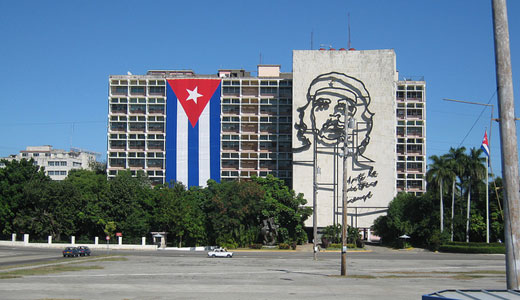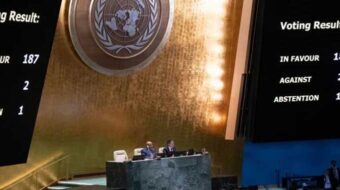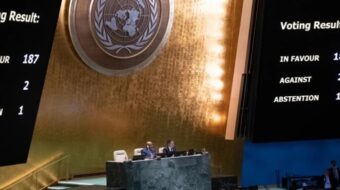
On July 22, an auto wreck in Cuba killed dissident leader Osvaldo Payá, head of the Christian Liberation Movement, and a Cuban colleague, and injured a Spaniard and a Swede who were riding in the same car. The incident illustrates the degree to which anti-socialist dissidents in Cuba are linked to important political circles both in the United States and Europe.
The accident happened near Bayamo in Eastern Cuba. The Spaniard, Angel Carromero, was driving, and a Swedish political activist, Jens Aron Modig, was dozing in the front seat. Payá and another Cuban dissident, Harold Cepero, were in the back seat. According to reports of Cuban police, the car was traveling at a high rate of speed when, having ignored warning signs, it hit a patch of road where the pavement had been taken up and was temporarily replaced by dirt surface with loose gravel. Carromero seems to have panicked and hit the brakes suddenly, causing the car to skid and slew off the road and collide sideways with a tree. The side of the car was bashed in, and Payá was killed instantly, while Cepero died in hospital as the result of an embolism. Modig and Carromero were slightly injured and treated, but also required to give testimony to Cuban authorities.
The propaganda machinery in dissident circles in Cuba and also in the United States immediately went into high gear. Payá’s family was cited as claiming the car had been hit from behind and driven off the road. Bogus websites even showed a photo of the supposed damage to a car, but it was a completely different car, not even the same color. The head of the U.S. National Endowment for Democracy put out an op-ed claiming that Payá had been murdered by the Cuban government. Republican Party candidate Mitt Romney jumped into the affray, hinting at political murder.
Payá, whose moment of glory had come in 2002, when he presented a petition to the Cuban People’s Power parliament calling for a referendum on structural changes (a petition which was rejected), had been seen as marginal to Cuba’s small scale dissident movement lately.
But on July 30, the two survivors of the crash spoke to reporters, telling them that there was no second car that had bumped them from behind or driven them off the road. It was an unfortunate accident. Those who have followed imperialism’s 50-year campaign to reverse the Cuban Revolution can predict that no mere infusion of truth or common sense will prevent the “Castro murdered Payá” meme from taking on a life of its own.
The accident does raise important political questions. First of all, what was a leading Cuban dissident doing blazing along the highways of Cuba in the company of Carromero and Modig? They are not your ordinary tourists, although they came into Cuba (deceptively) on tourist visas. Jens Aron Modig is the head of the youth branch of the Swedish Christian Democratic Party, a right-wing junior member of the conservative coalition that currently rules Sweden. Carromero is a leader of the youth branch of the People’s Party, or PP, the right-wing party of Spanish Prime Minister Mariano Rajoy. The PP has roots in the Franco-fascist period in Spain, and the PP’s former Prime Minister, Felipe Aznar, is one of the leading anti-Cuba politicians in Europe; he has been quoted as hinting that former Cuban President Fidel Castro should meet the same fate as Gadaffi of Libya.
Moreover, there are claims that on their way to hook up with Payá in Cuba, the two Europeans had met in the United States with the International Republican Institute and the National Democratic Institute, dependencies of the National Endowment for Democracy and recipients of U.S. taxpayer money directed to the purpose of overthrowing the Cuban government, as well as those of other left-leaning Latin American countries. And as if to drive home the point, Modig, in Havana, said he recognized that bringing in money to give to Cuban dissidents was illegal and apologized for so doing.
Modig said that the money was for establishing a youth branch of Payá’s organization.
So there you have it: Connivance on the part of major U.S. and European political entities connected to major power centers in funding efforts to destabilize Cuba, and working through so called “independent” Cuban dissidents.
This is one more piece of evidence that our tax money is used to violate international law and to violate the sovereignty of other nations. And you can bet that this is just the tip of the iceberg.
On July 26, anniversary of the attack on the Moncada Barracks and a major holiday in Cuba, President Raul Castro stated for the umpteenth time that his government is ready to meet with the United States government and talk about anything at all, but on a basis of equality. A U.S. State Department spokesperson immediately belittled the offer.
That is unfortunate. It is time to defund entities like the National Endowment for Democracy, and sit down over mojitos and talk, for heaven’s sakes.
Photo: Cuba’s Department of Security building. WaterpoloSam // CC 2.0

MOST POPULAR TODAY

High Court essentially bans demonstrations, freedom of assembly in Deep South

U.S. imperialism’s ‘ironclad’ support for Israel increases fascist danger at home

UN warns that Israel is still blocking humanitarian aid to Gaza

Resource wars rage in eastern Congo, but U.S. capitalism only sees investment opportunity







Comments